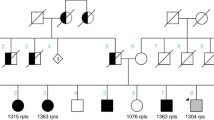Abstract
Hereditary cerebellar ataxias, including spinocerebellar ataxia type I (SCA1), dentato-rubro-pallidoluysian atrophy (DRPLA), and Machado-Joseph disease (MJD), have been associated with unstable CAG repeats. The length of the CAG repeat is a major factor in determining the age of onset of these diseases. In electrophoresis through acrylamide gels with formamide, the CAG repeat length following the polymerase chain reaction (PCR) coincides with the sequence-determined repeat length after subcloning. However, without formamide, PCR products with long CAG repeats appear 1–4 repeats shorter than when electrophoresed with formamide, and the repeat lengths are variable. In addition, the larger the CAG repeats are, the more difficult are the PCR reactions. A mixture containing thermostableTaq andPwo DNA polymerases (so-called “long PCR”) is much more sensitive than that withTaq polymerase alone in detecting expanded CAG repeats. Therefore, highly denaturing conditions, especially formamide gel electrophoresis, and the “long PCR” protocol should be used to evaluate the exact CAG repeat length. We have used these principles to detect unstable CAG repeats. The normal ranges are 14–34 repeats for MJD, 6–31 repeats for DRPLA, and 21–32 repeats for SCA1.
Similar content being viewed by others
References
Andrew SE, Goldberg YP, Kremer B, Telenius H, Theilmann J, Adam S, Starr E, Squitieri F, Lin B, Kalchman MA, Graham RK, Hayden MR (1993) The relationship between trinucleotide (CAG) repeat length and clinical features of Huntington's disease. Nat Genet 4:398–403
Barnes WM (1994) PCR amplification of up to 35-kb DNA with high fidelity and high yield from λ bacteriophage templates. Proc Natl Acad Sci USA 91:2216–2220
Cheng S, Fockler C, Barnes WM, Higuchi R (1994) Effective amplification of long targets from cloned inserts and human genomic DNA. Proc Natl Acad Sci USA 91:5695–5699
Chung M, Ranum LPW, Duvic LA, Servadio A, Zoghbi HY, Orr HT (1993) Evidence for a mechanism predisposing to intergenerational CAG repeat instability in spinocerebellar ataxia type I. Nat Genet 5:254–258
Cohen J (1994) ”Long PCR“ leaps into larger DNA sequences. Science 263:1564–1565
Duyao M, Ambrose C, Myers R, Novelletto A, Persichetti F, Frontali M, Folstein S, Ross C, Franz M, Abbott M, Gray J, Conneally P, Young A, Penny J, Hollingsworth Z, Shoulson I, Lazzarini A, Falek A, Koroshetz W, Sax D, Bird E, Vonsattel J, Bonilla E, Alvir J, Bickham Conde J, Cha J-H, Dure L, Gomez F, Ramos M, Scanchez-Ramos J, Snodgrass S, Young M de, Wexler N, Moscowitz G, Penchaszadeh G, MacFarlane H, Anderson M, Jenkins B, Srinidhi J, Barnes G, Gusella J, MacDonald M (1993) Trinucleotide repeat length instability and age of onset in Huntington's disease. Nat Genet 4: 387–392
Ikeuchi T, Koide R, Tanaka H, Onodera O, Igarashi S, Takahashi H, Kondo R, Ishikawa A, Tomoda A, Miike T, Sato K, Ihara Y, Hayabara T, Isa F, Tanabe H, Tokiguchi S, Hayashi M, Shimizu N, Ikuta F, Naito H, Tsuji S (1995) Dentatorubral-pallidoluysian atrophy: clinical features are closely related to unstable expansions of trinucleotide (CAG) repeat. Ann Neurol 37:769–775
Kawaguchi Y, Okamoto T, Taniwaki M, Aizawa M, Inoue M, Katayama S, Kawakami H, Nakamura S, Nishimura M, Akiguchi I, Kimura J, Narumiya S, Kakizuka A (1994) CAG expansions in a novel gene for Machado-Joseph disease at chromosome 14q32.1. Nat Genet 8:221–228
Kawakami H, Maruyama H, Nakamura S, Kawaguchi Y, Kakizuka A, Doyu M, Sobue G (1995) Unique features of the CAG repeats in Machado-Joseph disease. Nat Genet 9:344–345
Koide R, Ikeuchi T, Onodera O, Tanaka H, Igarashi S, Endo K, Takahashi H, Kondo R, Ishikawa A, Hayashi T, Saito M, Tomoda A, Miike T, Naito H, Ikuta F, Tsuji S (1994) Unstable expansion of CAG repeat in hereditary dentatorubral-pallidoluysian atrophy (DRPLA). Nat Genet 6:9–13
Komure O, Sano A, Nishino N, Yamauchi N, Ueno S, Kondoh K, Sano N, Takahashi M, Murayama N, Kondo I, Nagafuchi S, Yamada M, Kanazawa I (1995) DNA analysis in hereditary dentatorubral-pallidoluysian atrophy: correlation between CAG repeat length and phenotypic variation and the molecular basis of anticipation. Neurology 45:143–149
Maruyama H, Nakamura S, Matsuyama Z, Sakai T, Doyu M, Sobue G, Seto M, Tsujihata M, Oh-i T, Nishio T, Sunohara N, Takahashi R, Hayashi M, Nishino I, Ohtake T, Oda T, Nishimura M, Saida T, Matsumoto H, Baba M, Kawaguchi Y, Kakizuka A, Kawakami H (1995) Molecular features of the CAG repeats and clinical manifestation of Machado-Joseph disease. Hum Mol Genet 4:807–812
Matilla T, Volpini V, Genis D, Rosell J, Corral J, Davalos A, Molins A, Estivill X (1993) Presymptomatic analysis of spinocerebellar ataxia type 1 (SCAT) via the expansion of the SCA1 CAG-repeat in a large pedigree displaying anticipation and parental male bias. Hum Mol Genet 2:2123–2128
Nagafuchi S, Yanagisawa H, Sato K, Shirayama T, Ohsaki E, Bundo M, Takeda T, Tadokoro K, Kondo I, Murayama N, Tanaka Y, Kikushima H, Umino K, Kurosawa H, Furukawa T, Nihei K, Inoue T, Sano A, Komure O, Takahashi M, Yoshizawa T, Kanazawa I, Yamada M (1994) Dentatorubral and pallidoluysian atrophy expansion of an unstable CAG trinucleotide on chromosome 12p. Nat Genet 6:14–18
Orr HT, Chung M, Banfi S, Kwiatkowski TJ, Servadio A, Beaudet AL, McCall AE, Duvick LA, Ranum LPW, Zoghbi HY (1993) Expansion of an unstable trinucleotide CAG repeat in spinocerebellar ataxia type 1. Nat Genet 4:221–226
Rosenberg RN (1995) Autosomal dominant cerebellar phenotypes: the genotype has settled the issue. Neurology 45: 1–5
Sambrook J, Fritsch EF, Maniatis T (1989) Molecular cloning: a laboratory manual, 2nd edn. Cold Spring Harbor Laboratory, Cold Spring Harbor, NY
Snell RG, MacMillan JC, Cheadle JP, Fenton I, Lazarou LP, Davies P, MacDonald ME, Gusella JF, Harper PS, Shaw DJ (1993) Relationship between trinucleotide repeat expansion and phenotypic variation in Huntington's disease. Nat Genet 4: 393–397
United States Biochemical Corporation (1990) Formamide gels (40%) for sequencing DNA. USB Comments 17:31
Author information
Authors and Affiliations
Rights and permissions
About this article
Cite this article
Maruyama, H., Kawakami & Nakamura, S. Reevaluation of the exact CAG repeat length in hereditary cerebellar ataxias using highly denaturing conditions and long PCR. Hum Genet 97, 591–595 (1996). https://doi.org/10.1007/BF02281866
Received:
Revised:
Issue Date:
DOI: https://doi.org/10.1007/BF02281866




